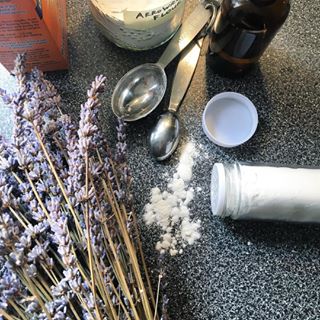For the Love of Lavender
/I have a confession to make: I adore lavender. In fact, maybe adore isn’t the right word. I LOVE it! You know how some people need to stop and say “hi” or pet a dog that they pass on the street? Well, I need to smell lavender. Every. Single. Time. I pass it. Like a magnet I gravitate towards it and don’t even realize I’m doing so until it’s too late – my head and hands are already in the shrub. I’m almost positive that if you live in Hamilton and have lavender growing in your front yard, close to the curb or sidewalk, I’ve stopped to smell it. I’ve been caught once or twice, which probably embarrasses my husband more than me, but I simply give a big a smile and holler, “it’s lovely!” I find the smell intoxicating and immediately feel calm afterwards. Why is that? Let’s explore lavender together.
Lavender has many different known species but the most widely cultivated one is Lavandula angustifolia (formerly known as Lavendula officinalis). It’s originally from France and is part of the Labiatae botanical family, which includes herbs such as basil, peppermint, thyme and rosemary. To extract the aromatic essence, the flowering tops are distilled using heat or steam. This process sees the plant cells break down and the oils release as vapour. The vapour is then cooled, so it can return to liquid form, and the oils collected.
The term “aromatherapy” was coined in 1928 by a French chemist named René-Maurice Gattefossé who trained as a chemical engineer and worked in his family’s perfumery business. In the 1920s he investigated the antiseptic and therapeutic properties of essential oils and re-discovered lavender (thanks in part to a chemical accident that left a burn on his hand that he was able to eventually heal with lavender essential oil)…and for that I have a lot to thank him for. You see, even though essential oils were used for centuries before (especially by the Egyptians), Gattefossé’s research helped bring a renewal and structure to the contemporary discipline and lavender was one of his favourites, writing several articles on the subject. Thanks to his research, and many others, we now know how incredible and extremely versatile lavender can be. It can have a cooling or warming effect on the body, is cleansing and detoxifying yet soothing and calming. No other essential oil can perform such contradictory functions. It’s almost as if it adapts to what the body needs and complements the benefits of almost any other essential oil in a blend. Do you see why I love it so much?
The ways in which we can use lavender in our daily lives are endless but I’d like to highlight a couple that I’ve found useful over the past years: a dry shampoo and carpet/mattress cleaner.
For the dry shampoo use an old spice jar that’s been sterilized (either through the dishwasher or boiled), as you’ll want something with a perforated cap to help shake the mixture into your hands without releasing too much. These will usually hold 50 ml so the following is assuming this measurement; please adjust accordingly depending on your jar size. For light coloured hair mix 3 tablespoons of arrowroot powder, 1 teaspoon of baking soda and 5 drops of lavender essential oil in a bowl. For darker coloured hair mix equal parts arrowroot powder and cocoa powder (approx. 1.5 tablespoons of each), 1 teaspoon of baking soda and 5 drops of lavender. Mix well then transfer to your spice jar. To use, just sprinkle a few shakes into your hands first or directly onto your roots and blend using your fingers, gently massaging it into the scalp. The antibacterial and antiseptic properties of lavender shine here. In conjunction with the powders, they fight the excess oils without harming the balance of your hair or the use of nasty chemicals. Perfect for post-workout drinks with friends or a little boost between washes.
The carpet and mattress cleaner is quite simple but extremely effective. Simply mix 2 cups of baking soda with 20 drops of lavender essential oil. Place the mixture into a jar and sprinkle directly onto your mattress and/or carpet. Let it sit for 1-2 hours then vacuum it up (you might have to do this twice) and voila, your mattress and/or carpet are cleaned and smelling great. Baking soda is a natural deodorizer so works well here with the detoxifying properties of lavender.
Finally, another great and easy way to bring essential oils into your life is to add them to your bath as they have a profound effect on the body, both physiologically and psychologically. However, please note that essential oils do not naturally blend in water so you’ll need to give the water a little swish before getting in. The water shouldn’t be too hot and you should not exceed 5-7 drops for a full body bath. Here are some great combos using lavender essential oil:
For cramps: Place 1 cup of Epsom salt in the tub while it’s filling up. Then, once it’s filled and the water is turned off, mix in 4 drops of lavender essential oil, 2 drops of geranium essential oil and 1 drop of cypress essential oil.
For insomnia: Place 3 drops of lavender essential oil and 3 drops of chamomile (German or Roman) in a filled bath with the water turned off.
For relaxation: try the Ritual Island bath soak that includes Epsom salt, lavender, ylang ylang and eucalyptus.


